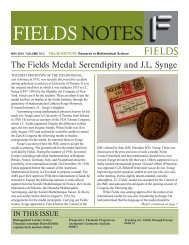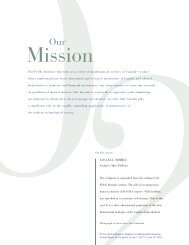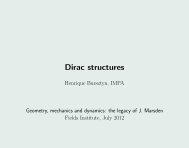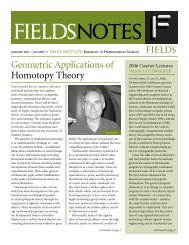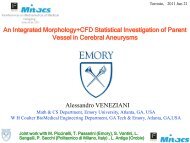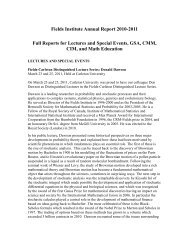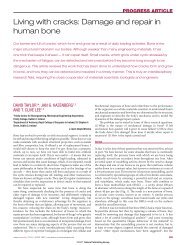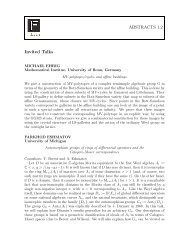Lakshminarayan V. Chinta - Fields Institute - University of Toronto
Lakshminarayan V. Chinta - Fields Institute - University of Toronto
Lakshminarayan V. Chinta - Fields Institute - University of Toronto
You also want an ePaper? Increase the reach of your titles
YUMPU automatically turns print PDFs into web optimized ePapers that Google loves.
Quantitative Perfusion Estimates from Two<br />
Photon Fluorescence Microscopy Maps<br />
Lak V. <strong>Chinta</strong>, Liis Lindvere, Bhupinder Sahota, John G. Sled,<br />
Bojana Stefanovic<br />
Sunnybrook Research institute<br />
Medical Biophysics, <strong>University</strong> <strong>of</strong> <strong>Toronto</strong>
The Brain<br />
1μm<br />
capillary<br />
neuron<br />
astrocyte<br />
microglia<br />
2% total body weight<br />
Consumes 20% O2 and 25% <strong>of</strong> glucose available to the body<br />
Neurovascular Coupling:<br />
Changes in neuronal activity are tightly coupled to changes in blood flow<br />
and oxygenation
Neurovascular coupling<br />
Brain Tissue<br />
increased neuronal activity<br />
Increased glial signaling<br />
Increased metabolism demand<br />
Mediators<br />
Cerebral Vasculature<br />
adaptation in flow, volume, and<br />
oxygenation <strong>of</strong> the vascular bed<br />
NO, GABA, 5HT, NE, DA, Ach, NPY, K+
Why neurovascular coupling is important?<br />
• Many models <strong>of</strong> neurovascular coupling have been proposed.<br />
- relating BOLD fMRI to neural activity seen on the millimeter scale<br />
• Mechanisms underlying neurovascular coupling are not fully understood<br />
- application <strong>of</strong> BOLD fMRI to the studies <strong>of</strong> stroke and brain diseases has had<br />
limited scope<br />
- the basic question is “what is the BOLD fMRI signal is measuring ?” or the lack <strong>of</strong><br />
detailed understanding <strong>of</strong> the neurovascular coupling at the micron level.<br />
• No model exists at the micron level that can help in understanding the link<br />
between neuronal and vascular 3D network state.<br />
• Understanding neurovascular coupling at the micron scale will support:<br />
- bottom-up modeling <strong>of</strong> BOLD fMRI signal<br />
- platform for characterization <strong>of</strong> alterations in brain hemodynamics in disease
The Challenge<br />
How do you quantitatively characterize neurovascular<br />
coupling on the micron scale in vivo ?<br />
Goal:<br />
Quantitative estimation <strong>of</strong> cerebral hemodynamics at<br />
the micron scale<br />
- Cerebral blood flow (CBF) refers to volume per minute moving through<br />
the vessels (nL/min)<br />
- Perfusion refers to nutrient supply by the blood through the capillary bed<br />
in the brain tissue (mL/g/min)
Fluorescent Dye<br />
Temperature<br />
Anesthetic<br />
Animal preparation<br />
Inter Cranial Pressure<br />
Arterial Blood Pressure (ABP)<br />
Blood Gas Analysis<br />
1. Surgery under iso-flourane<br />
2. Tracheotomy + mechanical ventilation<br />
3. Cannulation <strong>of</strong> tail vein, femoral artery and vein<br />
4. ICP recording via transducer placed inside<br />
subarachnoid space <strong>of</strong> the spine (lumbar region)<br />
5. Craniotomy over S1FL<br />
6. Imaging under alpha-chloralose<br />
7. IV administration <strong>of</strong> fluorescent dextran (Texas Red)<br />
Breath Rate<br />
Respiratory Pressure<br />
End Tidal pCO 2<br />
Electrical Stimulation<br />
Heart Rate<br />
O 2 Saturation<br />
Sprague-Dawley rats (120-150g)<br />
Imaging during:<br />
a. Anatomical 3D image<br />
following 33 mg/kg<br />
bolus Texas red dextran<br />
a. 2D time series <strong>of</strong> bolus<br />
injection
Resolution:<br />
~ 1μm lateral (x, y)<br />
~ 3μm axial (z)<br />
1% agarose<br />
pial artery<br />
2PFM Set-up<br />
capillary bed<br />
water immersion objective<br />
cover glass<br />
dental acrylic<br />
skull<br />
dura<br />
pial vein<br />
penetrating<br />
arterioles<br />
and venules<br />
Adapted from - Kherlopian et al. BMC Systems Biology<br />
2008 2:74
3D anatomical stacks acquisition<br />
• Microvasculature clearly visible up to 600μm.<br />
• Single 2D imaging plane is ~ 512 x 512 μm<br />
• Lateral resolution 1μm and axial resolution 3 μm
2D bolus time series<br />
• Single 2D imaging plane is ~ 250 x 250 μm<br />
• ~ 50 μm below the cortical surface at 0.31 ± 0.07 fps<br />
• Spatial resolution 1.59 μm/pixel
Analysis <strong>of</strong> perfusion estimation<br />
• Estimation <strong>of</strong> transit time (TT) from the bolus time series.<br />
• Identification <strong>of</strong> closed paths between vessels in the<br />
FOV <strong>of</strong> the bolus tracking plane.<br />
• Estimation <strong>of</strong> transit time in the individual segments<br />
(multiple paths).<br />
• Estimation <strong>of</strong> cerebral blood flow (CBF) and tissue<br />
volume irrigated.
Transit time estimation from<br />
bolus time series
Pre-processing <strong>of</strong> bolus time passage<br />
bolus time series<br />
vessels in FOV labeled<br />
MIP<br />
2D spatial median<br />
filtering<br />
t
Transit time estimation<br />
• The signal intensity curves from bolus passage are<br />
normalized and integrated over time.<br />
• We model the bolus passage as a linear dynamical<br />
process.
Second-order plus dead time model<br />
(SOPDT)<br />
• SOPDT model function (Rangiah et al. 2006) was used<br />
to estimate damping ratio ( ), natural frequency ( ) and<br />
dead time ( ).<br />
• Laplace domain transfer functions<br />
were then calculated:<br />
G ( s )<br />
G ( s )<br />
s<br />
6 2<br />
2 2<br />
t<br />
2<br />
e<br />
s<br />
n n<br />
e<br />
2 . 2 s<br />
s 0 . 0 1 7 7 s<br />
0 . 0 0 0 1
• Impulse response <strong>of</strong> the transfer functions was used to<br />
calculate the onset time and peak time.<br />
t ; t<br />
Second-order plus dead time model<br />
o p<br />
t a n<br />
1<br />
n<br />
1<br />
1<br />
2<br />
2<br />
(SOPDT)
Transit time estimation<br />
• Transit time (normalized to earliest onset time) is<br />
computed as<br />
t t ( t t ) m i n ( t )<br />
o p o<br />
sec
Identification <strong>of</strong> closed paths<br />
and estimation <strong>of</strong> TT in the<br />
individual segments
Segmentation <strong>of</strong> the 3D vascular stacks<br />
• Imaris (Bitplane Scientific S<strong>of</strong>tware) was used for semi-automated<br />
segmentation <strong>of</strong> the 3D vascular network.<br />
• Vertex-wise radii and x,y,z coordinates
Registration <strong>of</strong> bolus plane to the 3D<br />
2D image plane from bolus tracking on<br />
the 3D image<br />
network<br />
2D image plane from bolus tracking<br />
on the 3D segmented image
Closed path identification<br />
• Closed path identification between any two vessels <strong>of</strong><br />
the bolus tracking plane by tracing through the 3D<br />
network.
Perfusion estimation – closed paths<br />
• For direct closed paths, perfusion and CBF estimation is<br />
can be computed easily<br />
• CBF = CBV/TT (from the central volume principle)<br />
• Perfusion = CBF/tissue volume irrigated
Perfusion estimation - multiple paths<br />
• But, what if we have multiple connecting paths? How do<br />
you estimate perfusion in these individual segments?
The problem in multiple paths<br />
• We need to analyze the contributions <strong>of</strong> CBF in each <strong>of</strong><br />
the segments
Modeling CBF in individual segments<br />
• We approach the problem by modeling CBF as current<br />
flowing in a closed path.
TT estimation in individual segments<br />
• We solve for the unknown transit time in the individual<br />
segments based on equations <strong>of</strong> transit time and CBF.<br />
3<br />
t t t t t t t t t t t t t t<br />
a b c d f g<br />
t t t t t t t t t t t t t t<br />
a b c e f g<br />
e<br />
a b c<br />
1<br />
c<br />
3 9<br />
3 9<br />
C B V / t t C B V / t t C B V / t t<br />
0<br />
c c e e d d<br />
f<br />
d<br />
e<br />
d<br />
g<br />
9
Estimation <strong>of</strong> CBF and tissue<br />
volume irrigated by the<br />
individual segments
CBF estimation in individual segments<br />
• We can compute CBF=CBV/TT (central volume<br />
principle)<br />
• CBF values coded in the individual segments<br />
nL/min
Estimation <strong>of</strong> tissue volume irrigated<br />
• For perfusion, we need the tissue volume irrigated by the<br />
individual segments.<br />
• Based upon the 2PFM literature, oxygen diffusion<br />
distance in the rat’s somatosensory cortex is ~40-68 m<br />
(Masamoto et al. 2007).<br />
• Tissue volume irrigated can be estimated as a<br />
convolution <strong>of</strong> ~65 μm sphere and our vascular subtree<br />
centre lines.
Perfusion estimation<br />
mL/g/min<br />
3.237<br />
2.884<br />
2.530<br />
2.176<br />
1.822<br />
1.468<br />
1.115<br />
0.761<br />
0.407<br />
0.053<br />
• Perfusion values are coded in the individual segments.<br />
Z<br />
600<br />
500<br />
400<br />
300<br />
200<br />
100<br />
0<br />
400<br />
300<br />
200<br />
Y<br />
100<br />
0<br />
0<br />
100<br />
X<br />
200<br />
300<br />
400
Heterogeneity in perfusion and CBF<br />
~16.67% low mean perfusion 0.20 ± 0.02 mL/g/min<br />
~61% physiological range 0.68 ± 0.29 mL/g/min<br />
~19.44% mean perfusion 1.70 ± 0.38 mL/g/min<br />
~2.74% perfusion value 3.23 mL/g/min
Heterogeneity in perfusion across rats<br />
~7.4% low mean perfusion 0.16 ± 0.09 mL/g/min<br />
~33.3% physiological range 0.64 ± 0.28 mL/g/min<br />
~37.04% mean perfusion 1.72 ± 0.35 mL/g/min<br />
~22.2% high mean perfusion 3.92 ± 1.24 mL/g/min<br />
~11.76% low mean perfusion 0.18 ± 0.01 mL/g/min<br />
~41.8% physiological range 0.68 ± 0.41 mL/g/min<br />
~23.53% mean perfusion 1.77 ± 0.28 mL/g/min<br />
~23.53% high mean perfusion 3.91 ± 1.83 mL/g/min
Perfusion estimation across modalities<br />
• In the somatosensory cortex <strong>of</strong> rats under the same anesthesia<br />
protocol<br />
Optical Coherence Tomography (Boas 2010) ~0.51-0.68 mL/g/min<br />
Iodo[14C]antipyrine autoradiographic studies (Nakao 2001) ~0.6 mL/g/min<br />
• Our results show 48.7% <strong>of</strong> the segments within the physiological<br />
range with median perfusion <strong>of</strong> 0.61 mL/g/min.
Conclusion<br />
• Results show evidence <strong>of</strong> heterogeneity in perfusion: we<br />
expect this heterogeneity to relate to local vascular<br />
density.<br />
• A novel methodology to estimate perfusion at the micron<br />
level was developed: its application to a cohort <strong>of</strong><br />
subjects may relate cortical microvascular topology and<br />
blood flow.<br />
• Estimation <strong>of</strong> functional perfusion and CBF at the<br />
micron scale.
Acknowledgements<br />
• Supervisor: Bojana Stefanovic<br />
• Collaborator: John G. Sled<br />
• Lab<br />
David Chartash<br />
Simone Chaudhary<br />
Adrienne Dorr<br />
Eve Lake<br />
Liis Lindvere<br />
Martijn van Raaji<br />
Bupinder Sahota<br />
Andrew Stanisz<br />
Kun Zhang<br />
SiMing Zhang<br />
• SRI (Neuro group)<br />
• CIHR






